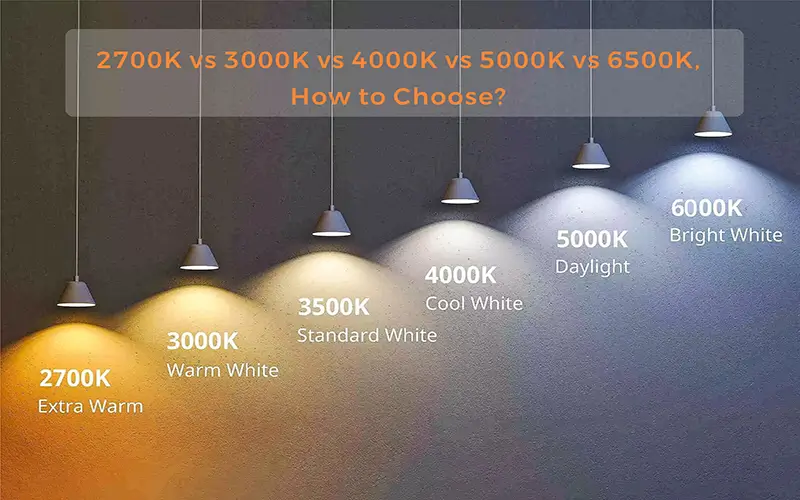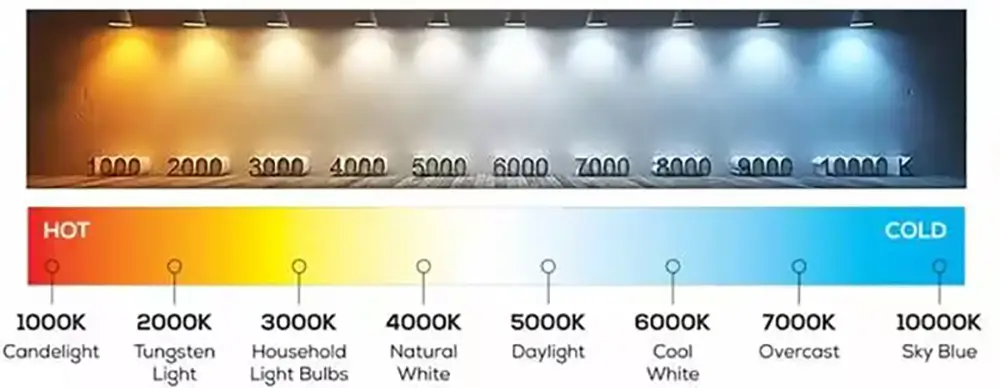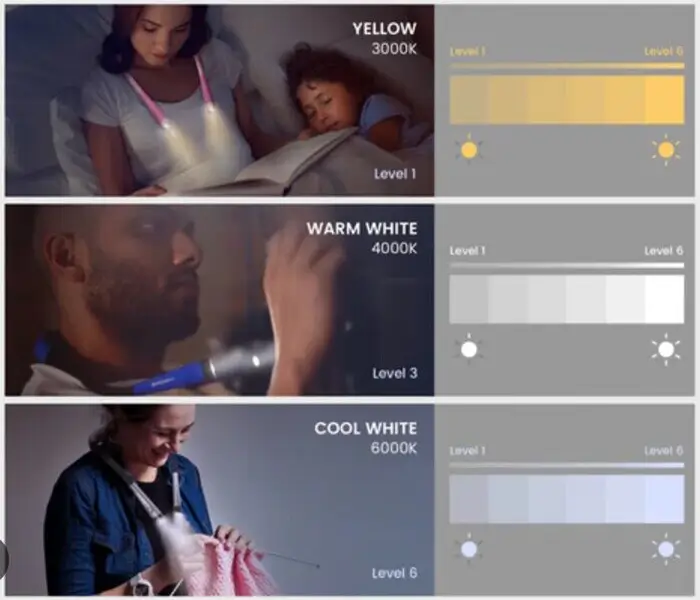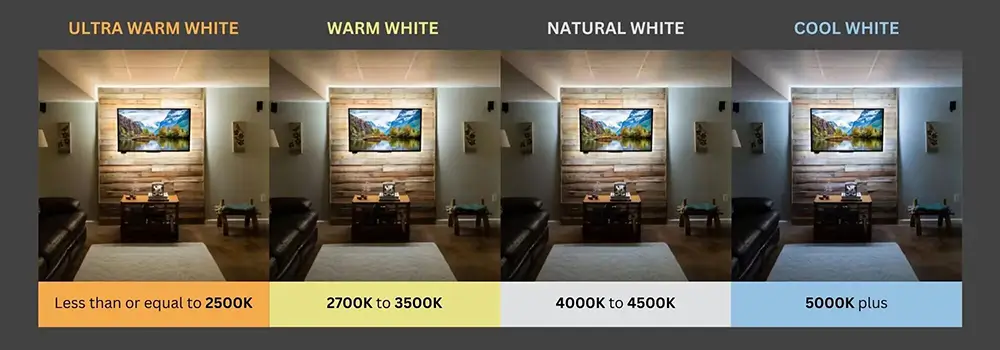
In LED lighting systems, correct color temperature is crucial. It can significantly affect the atmosphere and functionality of a space. Users generally choose from warm white light to cool daylight, and choose the right color temperature that looks visually appealing, creates an atmosphere and brings good mood and energy. This article will delve into the nuances of different color temperatures (including 2700K vs 3000K vs 4000K vs 5000K vs 6500K), how different color temperatures affect mood, and how to choose them correctly.
What is Color Temperature?
Color temperature is a numerical representation of the color appearance of light emitted by an LED light source. Typically, it is measured in Kelvin (K) and ranges from 1,000 to 10,000. It characterizes the warmth or coolness of light.
We can find that lower Kelvin values represent warmer tones and higher values represent cooler tones. Typically, the Kelvin temperature range for commercial and residential lighting applications is 2700K to 6500K.

Why Is It Important to Choose the Right Color Temperature?
Choosing the right color temperature is crucial. Because LED color temperature will affect the user’s mood, atmosphere and space functions. Warm colors create a cozy and welcoming atmosphere, while cool colors promote alertness and productivity.
- Helps you attract more customers as they will be attracted by the harmonious color temperature
- It is unlikely to irritate the eyes and cause eye discomfort.
- Allows you to see the correct products you need to buy and avoid unnecessary or multiple purchases.
- May affect mood and activity in certain environments, such as changing mood from bright to dark.
- Helping you attract more customers as they will be attracted by the harmonious color temperature.
What is 2700K?
2700K is a warm white light, and the light it emits is similar to ordinary traditional incandescent light bulbs, with a soft yellowish light. It is mainly suitable for creating a relaxing and comfortable atmosphere in residential spaces such as living rooms, bedrooms and dining areas.
What is 3000K?
Compared to 2700K, 3000K also belongs to the warm white spectrum. But its light will be slightly brighter and clearer. It is commonly used in residential and commercial settings, including living rooms, bathrooms, and retail spaces where a balance of warmth and brightness is required.
What is 4000K?
4000K is a neutral light known as natural white light, which can provide a balanced mix of warm and cool colors. Like as 3000K vs 4000K, the 4000K is suitable for a variety of lighting applications, including kitchens, offices, hospitals and educational facilities. 4000K can guarantee a certain degree of clarity and visibility.
What is 5000K?
5000K is considered cool white light, which emits brighter and more vibrant lighting than 4000K. It is commonly used in work spaces, garages and outdoor areas where greater visibility and alertness are required.
What is 6500K?
6500K daylight white light, bluish tint. It closely resembles natural daylight and is commonly used in industrial and outdoor environments where precise color rendering and improved visibility are critical.
How Does Warm White/Natural White/Cool White Affect Mood?
Different colors do affect an individual’s mood, so choose the right color temperature is so important.

2700K-3000K color temperature
- The warm color temperature in the room of 2700K–3000K (i.e. warm yellow light) can trigger sleep hormones such as melatonin. This can help you fall asleep faster and more efficiently.
- Warm white light (2700K–3000K) tends to evoke feelings of comfort, relaxation and intimacy and is suitable for residential environments.
- 2700K offers a very nice and warm ambience and is a great choice for living rooms and bedrooms where you want to promote relaxation.
4000K color temperature
- 4000K is a neutral white, and the color is slightly neither warm nor cold. 4000K lights have a lighter yellowish white tone.
- Above 4000K, blue begins to dominate the light, with 5000K and 6000K color temperatures approaching white light and daylight colors.
- And natural white light (4000K) promotes focus, productivity and vision, making it suitable for task-oriented spaces.
5000K-6500K color temperature
- Cool white light (5000K–6500K) is a comfortable cold light with a blue tint. It is used indoors in kitchens and bathrooms, and it is more suitable for industrial task lighting.
- Cool (5000K–6500K) blue light-covered rooms can make people more alert and can increase alertness, energy levels and concentration, suitable for work spaces and outdoors.
2700K vs. 3000K vs. 4000K vs. 5000K vs. 6500K, Which is Better?
There is no best way to choose which color temperature to use. It’s about which color temperature is more suitable for your lighting project. So when choosing between different color temperatures, consider the specific requirements of your space, lighting purpose, environment and personal preference.

- Warm colors (2700K–3000K) create a warm, comfortable and private environment.
- Neutral tones (4000K) for balanced lighting.
- Cool colors (5000K-6500K) to increase visibility and alertness.
Importance of CRI
In addition to color temperature, we also need to consider the color rendering index (CRI). 0-100 is used as a measurement standard. Generally, lighting with CRI80/90 or later is selected. Because it is a measure of a light source’s ability to accurately render colors.
A higher CRI value indicates higher color fidelity. This is critical for applications where color accuracy is critical, such as art studios, retail stores and medical facilities.

Conclusion
The choice of color temperature plays an important role in shaping the atmosphere and functionality of a space. By understanding the 2700K vs 3000K vs 4000K vs 5000K vs 6500K definitions and applications in different application, users can choose the correct color temperature.
Whether you prefer the warmth of 2700K or the brightness of 4000K, choosing the right color temperature ensures optimal comfort, aesthetics and task performance in any environment. We can customize the color temperature of different LED strip lights to meet customer needs, please contact us if you are interested.
FAQs
Different color temperatures produce different lights, and can trigger different moods. 2700K emits a warm yellowish light similar to traditional incandescent light bulbs. 3000K provides a slightly brighter, clearer warm white light. 4000K provides a neutral white light that balances warm and cool colors. 5000K produces cool white light similar to daylight. 6500K emits a bright, cool white light similar to natural light.
2700K and 3000K are ideal for creating a cozy and welcoming atmosphere in residential spaces such as living rooms and bedrooms. And 4000K and 5000K are suitable for kitchens and bathrooms. 6500K is suitable for garage lighting.
4000K is more suitable for office environments and is a neutral white light. It doesn’t feel too harsh, while also improving concentration, productivity and vision.
Both 5000K and 6500K are suitable for outdoor lighting, but for ordinary outdoor lighting, 5000K is fine. If it is task lighting for large outdoor spaces, you should still use 6500K because it provides maximum visibility and alertness.
We recommend using neutral white light around 4000K for reading as it provides clarity and reduces eye strain. If the color temperature is too low or too high, it will cause eye discomfort. So it is very important to choose the appropriate color temperature for reading.
